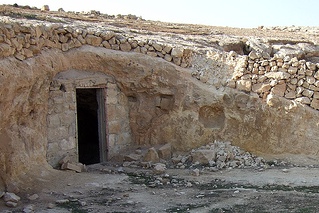
Israel’s Defense Ministry claims that eight West Bank villages, populated by over 1,000 Palestinian residents and continually inhabited since well before 1967, don’t actually constitute ‘home’ – and has served them with eviction orders.
I recently bought my first apartment, and cluttered as it is with stacks of books and boxes of my belongings, it is not home to some of my most important possessions. The artifacts of my childhood – photographs, toys, report cards, my first pair of shoes – all these remain in the house I grew up in, my parents’ house, where I know I can always let myself in, spend as much time as I want, and feel at home. But could the fact that my parent’s house will always feel like home mean that my own apartment isn’t my home?
I am hardly alone in my musings. The question of what makes a home has captivated the imaginations of artists, philosophers and social scientists throughout history. But recently the concept has taken on more concrete connotations in the context of a legal case I am working on, representing several communities of shepherds and farmers living in small historic villages in an area of the southern West Bank called Masafer Yatta.
The villagers live in ancient caves dug by their forefathers, and in tents pitched close to their flocks’ grazing grounds. The villages are scattered in the area, secluded from one another and lacking infrastructure. There are no paved roads leading to the villages, no electricity and no running water. The residents are therefore completely dependent upon the nearby town of Yatta for basic services. When a family member gets sick or is about to give birth, they go to the extended family’s house in town. When a teenager goes to school or finds work in Yatta, he might stay there throughout the week and come back home on weekends.
Could the existence of a family house in the town of Yatta undermine the fact that the villages constitute these families’ homes? Of course it can’t. Yet the Israeli Ministry of Defense is relying on precisely this absurd assertion to justify the forcible eviction of a thousand people from their homes in an area the IDF has declared a military training area.
Firing Zone 918, as it is called by the IDF, is a 33-square kilometer piece of land populated by over a thousand residents in twelve separate villages. In 1999 the majority of their residents were served with immediate evacuation orders and forcibly removed from their homes due to their “illegal dwelling in a fire zone.” As a result of a petition filed on the residents’ behalf, the High Court of Justice ordered the IDF to allow them to return their villages. However, legal proceedings have dragged on ever since, leaving the area’s population in a torturous state of limbo for thirteen years.
The Israeli military law that governs the West Bank prohibits the army from removing people from their “place of permanent residency”, even in a closed military area such as a firing zone. Obviously the state acknowledges that there are people present in Firing Zone 918; were there not, there would be no one to evict. So the IDF is claiming that the villages are not these people’s homes. To support this claim, the state is relying on allegations that some of my clients own homes in Yatta, and the fact that the military’s Civil Administration population registry lists Yatta as my clients’ place of residency.
It is not surprising that my clients, who live in villages that, according to the IDF Civil Administration, do not exist, would be registered as residents of the nearest town that the Civil Administration does recognize. Nor should we be impressed by testimony “revealing” houses in Yatta, since their existence is not in dispute. The fact that a shepherd can leave his village and spend a night in his extended family’s house does little to negate the fact that his home is in the village.
Indeed, the houses in Yatta could not exist were it not for the villages – their maintenance is dependent on the income earned from animal husbandry. The town of Yatta and its satellite villages are inextricably intertwined, characteristic of an ancient way of life unique to the micro-region. Living in caves to be near their flocks, maintaining traditional communal customs that have endured for hundreds of years, the villagers represent a living history of life in the region.
Ignoring the provisions of the Geneva Conventions explicitly prohibiting forcible removal of this population, Israeli authorities continue to claim that they can evacuate a thousand people from eight villages that have been continually inhabited since well before the area was occupied by Israel in 1967 because those villages aren’t really their homes. But if an eviction will make people homeless, where are they now, if not at home?
Tamar Feldman is Director of the Human Rights in the Occupied Territories Department at the Association for Civil Rights in Israel (ACRI).
This article was originally published in Ha’aretz on February 20.
To read more about the legal battle to prevent the eviction orders, click here.
To read an unofficial English translation of an expert opinion by social anthropologist Shuli Hartman on the lifestyle of the residents of Firing Zone 918, click here.







